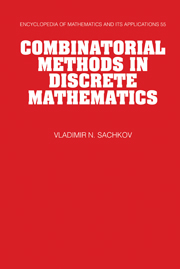5 - The general combinatorial scheme
Published online by Cambridge University Press: 22 March 2010
Summary
Beginning with Leibniz, a number of mathematicians have pointed out the fundamental importance of the distinguishability of objects in combinatorial problems, A rigorous definition of this notion requires certain formal notions which allow us to express the indistinguishability of objects in mathematical terms.
Consider as an example the formalization of the notion of indistinguishability in the well-known combinatorial scheme of allocation of particles to cells, usually referred as the urn model. There are m particles and n cells of unlimited capacity. The first problem consists of finding the number of possible allocations of the particles provided the allocations satisfy some restrictions. Obviously, in combinatorial problems of such a kind it is necessary to know which allocations are distinct and which ones are indistinguishable. First of all, the answer depends on whether the cells and the particles are distinguishable.
In Chapter 1 for such a formalization of combinatorial models we used the notion of a mapping of a finite set X into a set Y and introduced the notion of a configuration. With that approach the allocations of m particles into n cells were put into a one-to-one correspondence with configurations φ : X → Y, | X | = m, | Y | = n, and the distinguishability of allocations was defined in terms of the corresponding configurations. In this chapter we use another approach to the formalization of combinatorial schemes of the type considered, which is also based on the notion of a mapping. Let us illustrate the essence of the approach using the urn model again.
As the basic model we consider the scheme of allocation of m distinct particles to n different cells.
- Type
- Chapter
- Information
- Combinatorial Methods in Discrete Mathematics , pp. 209 - 271Publisher: Cambridge University PressPrint publication year: 1996



